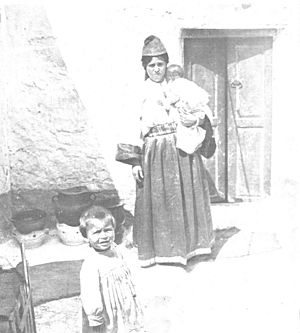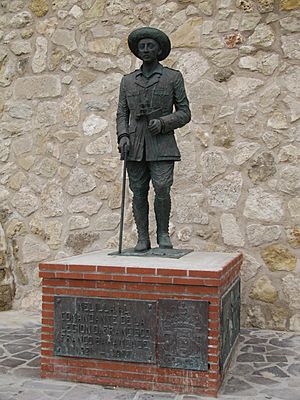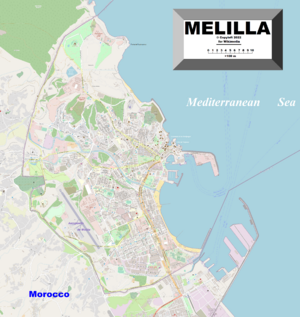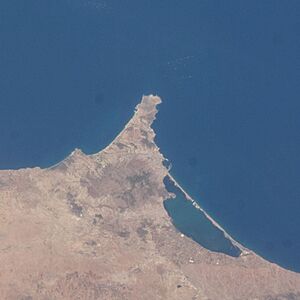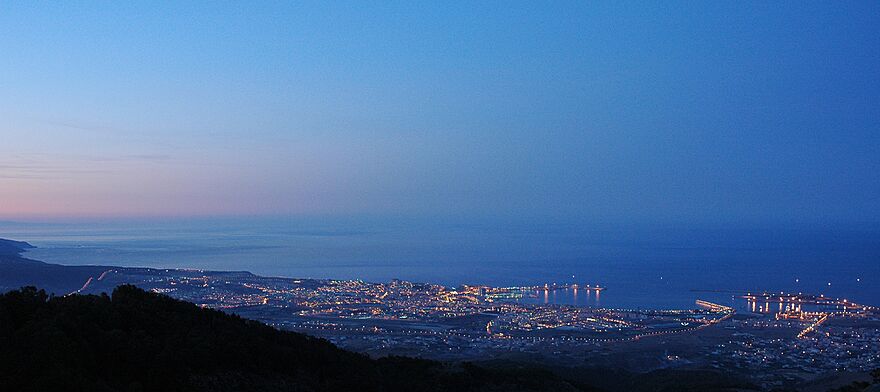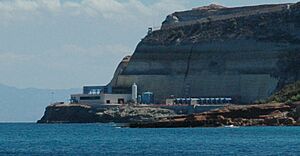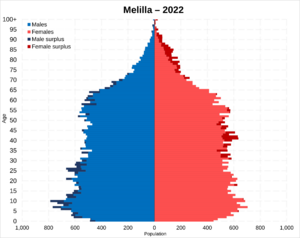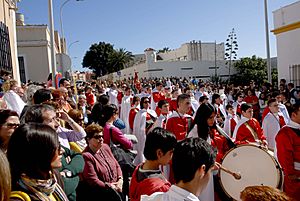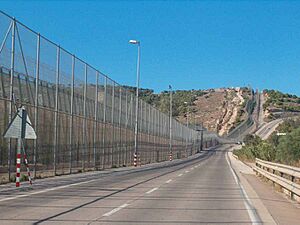Melilla facts for kids
Quick facts for kids
Melilla
Mřič
|
|||
|---|---|---|---|
|
|
|||
|
|||

Location of Melilla in Spain
|
|||
| Country | |||
| Area | |||
| • Total | 12.3 km2 (4.7 sq mi) | ||
| Area rank | 19th | ||
| Population
(2018)
|
|||
| • Total | 86,384 | ||
| • Rank | 18th | ||
| • Density | 7,023/km2 (18,190/sq mi) | ||
| • Density rank | 1st | ||
| • % of Spain | 0.16% | ||
| Demonyms | Melillan | ||
| GDP | |||
| • Total | €1.756 billion (2022) | ||
| • Per capita | €20,698 (2022) | ||
| Time zone | UTC+01:00 (CET) | ||
| • Summer (DST) | UTC+02:00 (CEST) | ||
| ISO 3166 code |
ES-ML
|
||
| Official languages | Spanish | ||
| Statute of Autonomy | 14 March 1995 | ||
| Parliament | Assembly of Melilla | ||
| Congress | 1 deputy (of 350) | ||
| Senate | 2 senators (of 264) | ||
| Currency | Euro (€) (EUR) | ||
| Website | www.melilla.es | ||
Melilla is a special autonomous city of Spain. It is located on the coast of North Africa. The city borders Morocco and faces the Mediterranean Sea.
Melilla covers an area of about 12.3 square kilometers. It was part of the Province of Málaga until 1995. That year, Melilla became an autonomous city with its own rules.
Melilla is a special territory of the European Union. People traveling between Melilla and other EU countries follow specific rules. This is part of Spain's agreement to join the Schengen Convention.
In 2019, Melilla had a population of 86,487 people. The population is mainly made up of people from Spain and the Rif region. There are also smaller groups of Sephardic Jews and Sindhi Hindus. People in Melilla speak both Spanish and Tarifit, a local language.
Morocco believes Melilla, along with Ceuta and other Spanish lands in Africa, should be part of Morocco. Spain does not agree with this claim.
Contents
- Understanding the Name Melilla
- Melilla's Long History
- Melilla's Geography and Climate
- Melilla's Economy
- Water Supply in Melilla
- Melilla's Architecture
- Melilla's Population and Cultures
- Border Security and Relations
- Transportation in Melilla
- Sports in Melilla
- Dispute with Morocco
- Famous People from Melilla
- Sister Cities
- Images for kids
- See also
Understanding the Name Melilla
The name Melilla comes from the Spanish language. It is pronounced like "mel-EE-ya." The name has been used since the 9th century. It comes from the Arabic word Malīlya.
Some people think the name is linked to honey. Melilla was known for beekeeping long ago. A bee even appeared on the city's old coins. Other ideas suggest the name means "discord" or "fever." It might also come from an Amazigh word meaning "white."
Melilla's Long History
Ancient Times and the Middle Ages
Melilla was first a trading post for the Phoenicians. Later, it was controlled by the Carthaginians. They called it Rusadir. After Carthage lost the Punic Wars, the city became part of the Roman Empire. The Romans made it a colony in AD 46.
Over time, Melilla was ruled by different groups. These included the Vandals, Byzantines, and Visigoths. After the Islamic conquest of North Africa, it was ruled by various Islamic empires. These included the Umayyads and Almoravids.
Early Modern Period
By the 1400s, Melilla became less important for trade. After Spain conquered Granada in 1492, they looked to expand into North Africa. Spanish leaders learned that the city was weak.
The Duke of Medina Sidonia suggested taking Melilla. The Spanish monarchs, Isabella I of Castile and Ferdinand II of Aragon, agreed. Spanish forces took Melilla on September 17, 1497. There was almost no fighting because the city was often abandoned. Spain did not expand much further into Africa after this.
Melilla was first managed by both the Duke and the Spanish Crown. Soldiers in Melilla were not paid well, so many left. The Duke gave up control of the garrison in 1556.
In the late 1600s, the Moroccan sultan Ismail Ibn Sharif tried to conquer Melilla. He took some outer forts but failed to capture the main city.
Recent History
The current borders of Melilla were set by agreements with Morocco between 1859 and 1894. In the late 1800s, Spain allowed Melilla to be the only trading center on the Rif coast. Trade grew, with goods like goat skins and beeswax being exported. Cotton goods and tea were imported.
In 1860, Melilla had only about 375 people. After it was declared a free port in 1863, the population grew. Many Sephardic Jews came from Tetouan to trade. Spanish people also moved to Melilla after 1868. This growth also attracted Berber people.
{{gallery mode="packed" captions="Views of Melilla taken from an elevated position in 1893" File:1893-10-30, La Ilustración Española y Americana, Vista general de la plaza de Melilla y de su campo, Venancio Álvarez Cabrera (cropped).jpg File:1893-10-30, La Ilustración Española y Americana, Vista general de la plaza de Melilla y de su campo, Venancio Álvarez Cabrera (cropped 2).jpg }}
In 1893, Riffian tribes tried to take the city. Spain sent 25,000 soldiers to defend it. This conflict was called the Margallo War. A new agreement in 1894 boosted trade even more. By 1896, Melilla had over 10,000 people.
In the early 1900s, France tried to reduce Melilla's trade. Mining companies began to operate near Melilla by 1908. A railway was built to connect the port and the mines. In 1909, workers were attacked, leading to more fighting.
In 1921, the Spanish suffered a major defeat at the Battle of Annual. They retreated to Melilla. The city was used as a starting point for the Spanish Civil War in 1936.
In 1986, a law made it easier for people born in Melilla to become Spanish citizens. This helped many Berber people gain citizenship.
Becoming an Autonomous City
In 1995, Melilla became an autonomous city. This meant it had more control over its own affairs.
In 2007, King Juan Carlos and Queen Sofia visited Melilla. It was the first time a Spanish monarch had visited in 80 years. This visit caused some protests from Morocco.
Since 2010, Melilla has officially celebrated the Muslim holiday of Eid al-Adha. This was the first time a non-Christian holiday was officially celebrated in Spain since the Reconquista.
In 2018, Morocco closed its customs office near Melilla. This office was expected to reopen in 2023.
Melilla was the last place in Spain to have a public statue of former dictator Francisco Franco. The statue was removed in 2021.
Melilla's Geography and Climate
Where is Melilla Located?
Melilla is in northwest Africa. It is on the coast of the Alboran Sea, part of the Mediterranean. The city is shaped like a wide semicircle around its beach and port. It sits on the eastern side of the Cape Tres Forcas peninsula.
The city is at the foot of Mount Gurugú. It is also near the mouth of the Río de Oro stream. The oldest part of the city, Melilla la Vieja, is a fortress built on a hill.
The Moroccan town of Beni Ansar is just south of Melilla. The city of Nador is also nearby. The ports of Melilla and Nador are in the same bay.
Melilla's Weather
Melilla has a warm Mediterranean climate. It is also close to a hot Semi-arid climate. Being near the sea makes summers cooler and brings more rain than inland areas. Temperatures do not change much between seasons.
The lowest temperatures have not dropped below 0°C (32°F) since 1991. Only about two days a year have temperatures above 35°C (95°F).
| Climate data for Melilla, altitude: 52 m (1991–2020) | |||||||||||||
|---|---|---|---|---|---|---|---|---|---|---|---|---|---|
| Month | Jan | Feb | Mar | Apr | May | Jun | Jul | Aug | Sep | Oct | Nov | Dec | Year |
| Record high °C (°F) | 27.0 (80.6) |
34.2 (93.6) |
29.6 (85.3) |
30.6 (87.1) |
33.0 (91.4) |
37.0 (98.6) |
41.8 (107.2) |
40.0 (104.0) |
36.0 (96.8) |
35.0 (95.0) |
34.0 (93.2) |
30.6 (87.1) |
41.8 (107.2) |
| Mean maximum °C (°F) | 21.5 (70.7) |
22.0 (71.6) |
23.8 (74.8) |
25.2 (77.4) |
28.9 (84.0) |
31.4 (88.5) |
35.6 (96.1) |
35.0 (95.0) |
31.7 (89.1) |
29.0 (84.2) |
26.3 (79.3) |
22.4 (72.3) |
36.5 (97.7) |
| Mean daily maximum °C (°F) | 16.9 (62.4) |
17.1 (62.8) |
18.5 (65.3) |
20.2 (68.4) |
22.9 (73.2) |
26.0 (78.8) |
29.0 (84.2) |
29.6 (85.3) |
27.0 (80.6) |
23.8 (74.8) |
20.2 (68.4) |
17.8 (64.0) |
22.4 (72.3) |
| Daily mean °C (°F) | 13.6 (56.5) |
13.9 (57.0) |
15.3 (59.5) |
16.9 (62.4) |
19.6 (67.3) |
22.7 (72.9) |
25.6 (78.1) |
26.3 (79.3) |
23.8 (74.8) |
20.6 (69.1) |
17.0 (62.6) |
14.6 (58.3) |
19.2 (66.6) |
| Mean daily minimum °C (°F) | 10.3 (50.5) |
10.8 (51.4) |
12.1 (53.8) |
13.6 (56.5) |
16.3 (61.3) |
19.4 (66.9) |
22.2 (72.0) |
23.1 (73.6) |
20.7 (69.3) |
17.4 (63.3) |
13.8 (56.8) |
11.4 (52.5) |
15.9 (60.6) |
| Mean minimum °C (°F) | 6.2 (43.2) |
6.9 (44.4) |
7.8 (46.0) |
9.9 (49.8) |
12.0 (53.6) |
15.8 (60.4) |
19.0 (66.2) |
20.1 (68.2) |
17.2 (63.0) |
13.3 (55.9) |
9.3 (48.7) |
7.4 (45.3) |
5.6 (42.1) |
| Record low °C (°F) | 0.4 (32.7) |
2.8 (37.0) |
3.4 (38.1) |
6.0 (42.8) |
9.4 (48.9) |
12.4 (54.3) |
16.0 (60.8) |
14.6 (58.3) |
13.6 (56.5) |
9.4 (48.9) |
5.0 (41.0) |
4.0 (39.2) |
0.4 (32.7) |
| Average precipitation mm (inches) | 55.3 (2.18) |
48.2 (1.90) |
43.6 (1.72) |
37.7 (1.48) |
15.2 (0.60) |
7.2 (0.28) |
0.5 (0.02) |
3.8 (0.15) |
18.9 (0.74) |
42.6 (1.68) |
53.3 (2.10) |
48.2 (1.90) |
374.5 (14.75) |
| Average precipitation days (≥ 1.0 mm) | 6.1 | 5.0 | 4.9 | 4.5 | 2.3 | 0.6 | 0.2 | 0.8 | 2.6 | 4.7 | 5.7 | 5.6 | 43 |
| Average relative humidity (%) | 73.1 | 72.9 | 72.8 | 70.8 | 68.5 | 68 | 67 | 69.8 | 73.6 | 75.7 | 74.5 | 74.4 | 71.8 |
| Mean monthly sunshine hours | 188.9 | 184.8 | 203.3 | 226.2 | 269.9 | 295.7 | 304.2 | 278.6 | 220.1 | 203.4 | 183 | 176 | 2,734.1 |
| Source 1: NCEI, Météo Climat | |||||||||||||
| Source 2: Infoclimat | |||||||||||||
Melilla's Economy
Melilla's total economic output was 1.6 billion euros in 2018. This was 0.1% of Spain's total economy. The money earned per person was 19,900 euros in 2018. This was the lowest in Spain for its region type.
Melilla is not part of the European Union Customs Union. It does not have VAT (IVA) tax. Instead, it has a local tax called IPSI. Imports are free of tariffs, with only the IPSI tax. Exports to the EU, including Spain, have regular customs tariffs and VAT.
The main industry in Melilla is fishing. Trade across the border and money from Spain and Europe also help the economy.
Melilla is connected to mainland Spain by air and sea. It also has strong economic ties with Morocco. Most of its fruits and vegetables come from Morocco. About 36,000 Moroccans cross the border daily to work or shop.
The port of Melilla has daily ferries to Almería and Málaga. Melilla Airport has daily flights to Almería, Málaga, and Madrid. Many people traveling between Europe and Morocco use the ferries to Melilla. This makes the port very important for the city's economy.
Tourism in Melilla
Melilla wants to attract more tourists. The Tourist Board offers discounts on travel packages. These packages include flights or boat trips and a place to stay in Melilla. The trip must be for ten days or less.
Water Supply in Melilla
Melilla used to get its water mainly from wells. But these wells were overused and the water quality got worse. Seawater also started to get into the wells.
To solve this, a desalination plant was built. It started working in 2007. This plant turns seawater into fresh drinking water. It can produce 22,000 cubic meters of water each day. The Spanish government helps pay for its daily operation.
People in Melilla buy more bottled water than the average Spanish person. This is similar to the Canary and Balearic Islands. The plant is being expanded to produce even more water, up to 30,000 cubic meters a day.
Melilla's Architecture
The Chapel of Santiago has a special dome. It was built in the mid-1500s. This dome is a rare example of Gothic architecture in Africa.
In the early 1900s, a new building style came to Melilla. This was the modernismo style, from Barcelona. It gave Melilla a unique architectural look. The architect Enrique Nieto designed many buildings.
Melilla has the second-largest collection of Modernista buildings in Spain, after Barcelona. Nieto designed the main Synagogue, the Central Mosque, and several Catholic Churches.
{{gallery mode="packed" File:Capilla de Santiago3.jpg|Dome of the Chapel of Santiago. File:EDIFICIO DEL ANTIGÜA REDACCIÓN EL TELEGRAMA DEL RIF.jpg|Modernista building, former newspaper office. File:Sinagoga Orr Zoruah, Ruta de los Templos (6) (5446069722).jpg|Local synagogue. File:Mezquita central melilla.jpg|Melilla's central mosque. }}
Melilla's Population and Cultures
Melilla is known for its many cultures. It is a city where Christians, Muslims, Jews, Hindus, and Buddhists live together.
Judaism in Melilla
Melilla might have the highest percentage of Jewish people in Spain. About 1,000 Jews live there today. This number is down from 7,000 in 1930. Many have moved to mainland Spain or Israel for economic reasons.
Melilla is important in the History of Jews in Spain. It was exempt from the expulsion of Jews from Spain. Many expelled Sephardic Jews found new homes in nearby Morocco, including Melilla. Melilla's unique location has made it a key center for Sephardic Judaism in Spain.
Christianity in Melilla
Roman Catholicism is the largest religion in Melilla. In 2019, 65% of Melillans said they were Roman Catholic. About 30% follow other faiths.
The Catholic churches in Melilla are part of the Diocese of Málaga.
Islam in Melilla
Muslims make up about half of Melilla's population.
Hinduism in Melilla
There is a small Hindu community in Melilla. They are important for trade. Their numbers have decreased as members move to mainland Spain. Today, there are about 100 Hindu members.
Languages Spoken in Melilla
Spanish is the official language in Melilla. Tarifit, a Berber language, is also widely spoken. Tarifit is mainly used in families and for talking, not often written.
People in Melilla can be Spanish speakers who only know Spanish. Others are from Tamazight-speaking families and know both Spanish and Tamazight. Moroccan immigrants often speak Tamazight best, with some Spanish. The Spanish spoken in Melilla is like the Andalusian dialect. The Berber language is similar to the Tarifit spoken in nearby Nador.
There have been efforts to recognize Berber in Melilla. However, these efforts have not succeeded. One reason is that the Berber language spoken there is not standardized.
Border Security and Relations
Protecting Melilla's Borders
The Spanish Armed Forces are in charge of defending Melilla. The Spanish Army has several units stationed there. These include infantry, cavalry, and artillery.
The military also protects islands and rock formations claimed by Spain off Morocco's coast. They make sure these areas are safe from Moroccan incursions. The Spanish Navy has a patrol boat based in Melilla.
The Civil Guard handles border security. They protect Melilla's fortified land border from people trying to cross illegally.
Relations Across the Border
Melilla and nearby Moroccan towns like Beni Ensar and Nador form a connected area. Melilla provides services, finance, and trade. Nador is more industrial. Other Moroccan towns provide workers.
Melilla's health services are used a lot by Moroccan citizens. This is because Melilla has better healthcare. Moroccan people from the province of Nador do not need visas to enter Melilla. This has led many Moroccans to move to Nador to get this exemption.
Relations between Melilla and its neighbors can be tense. This is because of the larger relationship between Morocco and Spain.
Securing the Border Fence
Since the 1990s, Melilla's border has been strengthened. This was to stop people from crossing illegally. The Melilla border fence is 6 meters (about 20 feet) tall and has two layers. It also has watchtowers.
Despite the fence, groups of migrants sometimes try to cross. Since 2005, at least 14 migrants have died trying. The Melilla migrant reception center can hold 480 people. In 2020, work began to remove barbed wire from the fence. The fence was also made taller in some areas, over 10 meters (33 feet) high.
In June 2022, a serious incident happened. About 2,000 migrants tried to storm the border. At least 23 migrants and two Moroccan security guards died. Many more were injured. The United Nations and human rights groups criticized the force used by border guards.
Morocco receives money from Spain and the European Union to help control migration. Besides the double fence on the Spanish side, there is also a 3-meter (10-foot) high fence with razor wire on the Moroccan side. There is also a moat between the fences.
Transportation in Melilla
Melilla Airport has flights to several Spanish cities. These include Málaga, Madrid, and Barcelona. Airlines like Air Nostrum and Iberia operate flights.
The city is also connected by ferry to Málaga, Almería, and Motril.
Three roads link Melilla to Morocco. Travelers must pass through border checkpoints on these roads.
Sports in Melilla
Melilla is a good place for surfing. The city's main football club is UD Melilla. They play in Spain's third football league. The club was founded in 1943. They play at the Estadio Municipal Álvarez Claro, which holds 12,000 fans.
UD Melilla used to play against AD Ceuta in a special derby. The teams traveled through mainland Spain to avoid entering Morocco. The second-best club in Melilla is Casino del Real CF.
Dispute with Morocco
The Moroccan government wants Spain to give Melilla, Ceuta, and other small Spanish territories to Morocco. Spain refuses, which causes tension between the two countries. Morocco often calls Ceuta "occupied Sebtah." They argue that Melilla is a colony because it is surrounded by Moroccan land.
This argument was first made by Alal-El Faasi, a Moroccan politician. He wanted Morocco to take Melilla by force. Spain and most other countries do not agree with Morocco's claim. Spain says Melilla has been part of Spain since the 1500s. This was centuries before Morocco became independent. Most people in Melilla want to remain part of Spain.
In 1986, Spain joined NATO. However, Melilla is not directly covered by NATO's main defense agreement. This is because Article 6 of the North Atlantic Treaty mainly covers Europe and North America. Some experts believe other parts of the treaty could cover Melilla.
In 2022, Spain raised the issue of Melilla's protection at a NATO meeting. NATO Secretary General Jens Stoltenberg said NATO would protect all allies. He added that it would be a political decision to use Article 5 for Melilla.
In 2020, Morocco's Prime Minister said Melilla was "Moroccan as the Sahara." Spain's government called the Moroccan ambassador to say that Spain expects its partners to respect its territory.
Famous People from Melilla
Sister Cities
Melilla is twinned with several cities:
 Caracas (Venezuela)
Caracas (Venezuela) Cavite City (Philippines)
Cavite City (Philippines) Ceuta (Spain)
Ceuta (Spain) Toledo (Spain)
Toledo (Spain) Málaga (Spain)
Málaga (Spain) Montevideo (Uruguay)
Montevideo (Uruguay) Motril (Spain); since January 2008
Motril (Spain); since January 2008 Almería (Spain)
Almería (Spain) Mantua (Italy); since September 2013
Mantua (Italy); since September 2013 Vélez-Málaga (Spain); since January 2014
Vélez-Málaga (Spain); since January 2014 Antequera (Spain); in process as of 2016
Antequera (Spain); in process as of 2016
Images for kids
See also
 In Spanish: Melilla para niños
In Spanish: Melilla para niños








